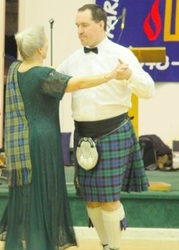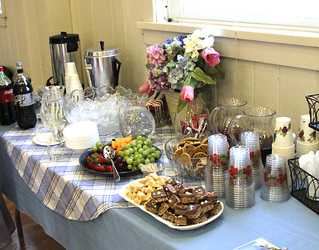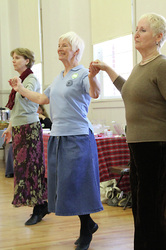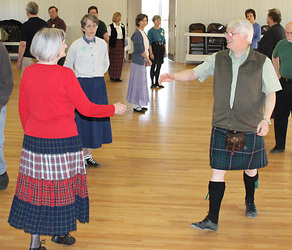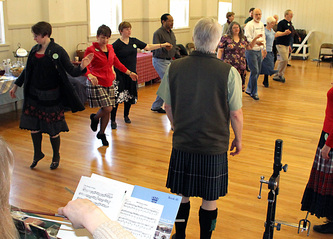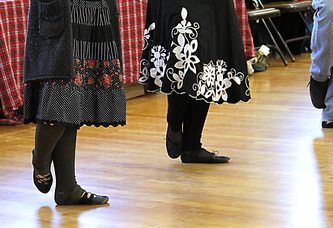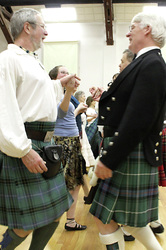The Do’s and Don’ts of Dance Decorum
Originally, etiquette for country dancing expressed values of gallantry as well as courtesy. Now we no longer dance in hooped crinolines, and we no longer expect our MC to wear a red coat and green shoes. We do, however, still need to follow some simple rules based on courtesy and consideration. Here are some guidelines, partly based on those published by Geoffrey and Cecily Selling of Philadelphia.
1.Do feel free to ask anyone to dance; formal introductions are not needed and partners may be of the same or opposite sex.
2.Do try to dance with a variety of different partners. If you’re an advanced dancer, invite a beginner for a dance you know is within his or her capacity. Dancing with you may make the beginner’s evening!
3.Do give a friendly hand to your partners as you walk to the set. The dancer who asks a partner to dance should find space on the floor.
4.Do try to dance in different parts of the floor during the evening. If you are an advanced dancer, don’t regard the top of the line as your peculiar property.
5.Do always join the set at the bottom. Don’t barge in above. If you wish to start as 4th couple, ask another couple to switch with you after the set has been formed. If you are joining a square set, make sure the existing sets are full before you start a new one.
6.The first man in each line, or the first couple together, should count off the sets in their line, and signal the MC as to how many more couples are needed. A woman holding a place in the set lines for her partner, should stand in the men’s sideline until sets have been counted off – or her partner joins her.
7.Do stay in your lines while sets are forming. Miscounts hold things up.
8.If you are more experienced than others in your set, do help them know where to go with gestures of by offering the correct hand or shoulder. Do use only the simplest of verbal instructions. Don’t shout and don’t push. If possible, let their partners help them.
9.Do give extra support to an elderly or weak dancer, even at the expense of your own technique.
10.Do relax and smile at others in the set. Remember that everyone makes mistakes. If a dance goes awry, stay calm and be ready to pick it up on the next phrase or the new repetition.
11.When the dance is over, do thank the set as well as your partner – everyone has contributed to your enjoyment. Don’t just rush off.
12.Do clear the floor between sets, and don’t form sets until the MC announces the next dance.
13.If you’re attending a dance sponsored by a group that does not brief dances, don’t stand up for a dance unless you know it. Even if the group does brief dances, make sure the figures are ones you know well.
14.Do try to avoid reading your “cheat sheet” while standing on the dance floor … it’s the place for sociability. Do study your dances beforehand, and review them quickly between dances.
15.Do enjoy the dance!
Originally, etiquette for country dancing expressed values of gallantry as well as courtesy. Now we no longer dance in hooped crinolines, and we no longer expect our MC to wear a red coat and green shoes. We do, however, still need to follow some simple rules based on courtesy and consideration. Here are some guidelines, partly based on those published by Geoffrey and Cecily Selling of Philadelphia.
1.Do feel free to ask anyone to dance; formal introductions are not needed and partners may be of the same or opposite sex.
2.Do try to dance with a variety of different partners. If you’re an advanced dancer, invite a beginner for a dance you know is within his or her capacity. Dancing with you may make the beginner’s evening!
3.Do give a friendly hand to your partners as you walk to the set. The dancer who asks a partner to dance should find space on the floor.
4.Do try to dance in different parts of the floor during the evening. If you are an advanced dancer, don’t regard the top of the line as your peculiar property.
5.Do always join the set at the bottom. Don’t barge in above. If you wish to start as 4th couple, ask another couple to switch with you after the set has been formed. If you are joining a square set, make sure the existing sets are full before you start a new one.
6.The first man in each line, or the first couple together, should count off the sets in their line, and signal the MC as to how many more couples are needed. A woman holding a place in the set lines for her partner, should stand in the men’s sideline until sets have been counted off – or her partner joins her.
7.Do stay in your lines while sets are forming. Miscounts hold things up.
8.If you are more experienced than others in your set, do help them know where to go with gestures of by offering the correct hand or shoulder. Do use only the simplest of verbal instructions. Don’t shout and don’t push. If possible, let their partners help them.
9.Do give extra support to an elderly or weak dancer, even at the expense of your own technique.
10.Do relax and smile at others in the set. Remember that everyone makes mistakes. If a dance goes awry, stay calm and be ready to pick it up on the next phrase or the new repetition.
11.When the dance is over, do thank the set as well as your partner – everyone has contributed to your enjoyment. Don’t just rush off.
12.Do clear the floor between sets, and don’t form sets until the MC announces the next dance.
13.If you’re attending a dance sponsored by a group that does not brief dances, don’t stand up for a dance unless you know it. Even if the group does brief dances, make sure the figures are ones you know well.
14.Do try to avoid reading your “cheat sheet” while standing on the dance floor … it’s the place for sociability. Do study your dances beforehand, and review them quickly between dances.
15.Do enjoy the dance!
|
_
|



